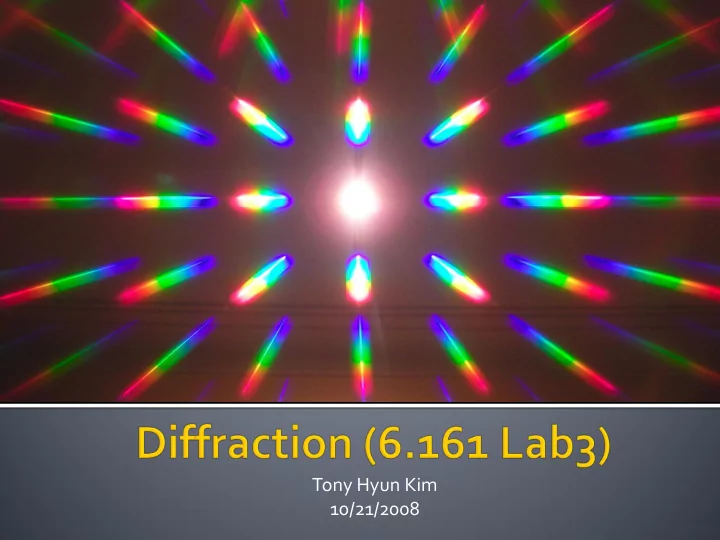

Tony Hyun Kim 10/21/2008
1. Introduction Diffraction theory 1. Fraunhofer diffraction integral 2. 2. Experimental setup 3. Patterns from apertures Single-slit 1. Double-slit 2. Rectangular aperture 3. Rectangular grid 4. 4. Conclusions
Although ray optics is intuitive… Light is a wave phenomenon
' ik 2 2 ( x y ) 2 ikz 2 z e e i ( x ' x y ' y ) z U x y u x y e dx dy ( , ) ' ( ' , ' ) ' ' i z '
' 2 2 I U ( x , y ) F ( u ' ( x ' , y ' ))
We’ll present and analyze (Topic set 1): 1. Single-slit 2. Double-slit 3. Rectangular aperture 4. Rectangular grid
b 2 z b Note Fourier reciprocity in characteristic lengths Calculate slit width from pattern: b = 89 microns
D 2 z D Periodicity in aperture produces localization in pattern Calculate inter-slit distance: D = 6.5 mm
Just a slit in two dimensions Calculate aperture dimensions: b = 76 microns
Again, periodicity localization
Verified Fraunhofer diffraction in lab General lessons: “Fourier pairing” between aperture and pattern Reciprocity in characteristic lengths. Periodicity of aperture Localization of pattern Possibilities for metrology
Lens system: http://www.trustedreviews.com/images/article/inline/4778-ZoomOut500.gif Fraunhofer planes: http://scienceworld.wolfram.com/physics/FraunhoferDiffraction.html Experimental setup: 6.161 Lab guide
Recommend
More recommend